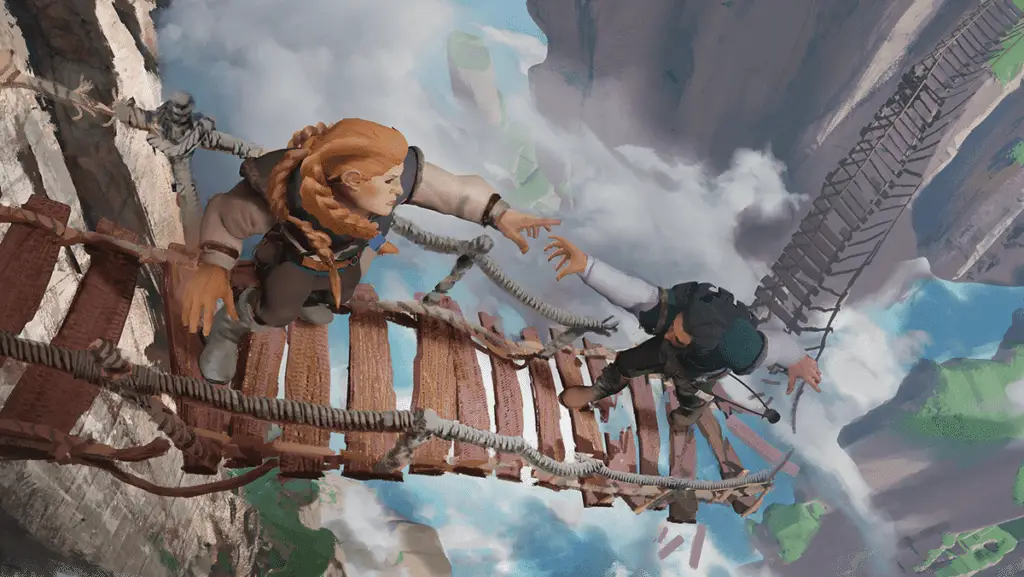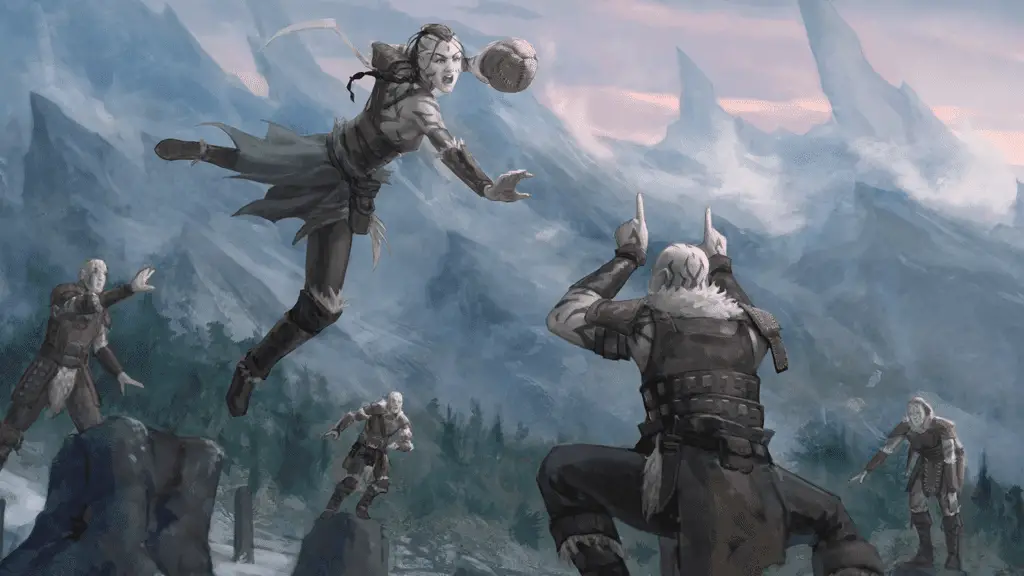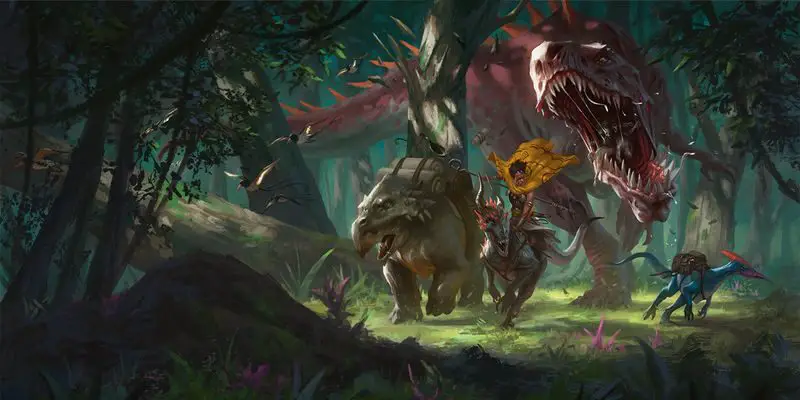Featured art and in-article art is property of Wizards of the Coast.
This article contains affiliate links that add gold to our coffers.
As the dinosaur’s roars shake the jungle, a drow mage conjures a giant web across a cliff, allowing his companions to climb to safety.
Beard dripping with saltwater, a dwarven carpenter patches a hole in the ship’s hull while a whirlpool threatens to pull her crew beneath the waves.
As guards’ shouts ring across the crowded street, a rebel leader scans nearby storefronts for signs of shelter.
Skill challenges are conflicts that go beyond combat or conversation. They demand creativity, teamwork, and resourcefulness as characters come together in a high-stakes, heart-pounding action sequence.
What is a Skill Challenge?
A skill challenge is an action scene: an adrenaline-fueled dash to the finish line. Whether that’s fleeing a T-Rex, escaping a whirlpool, or finding shelter from zealous guards, skill challenges are opportunities for excitement, tension, and quick thinking.
As the name suggests, skill challenges are trials that the characters can overcome through the judicious use of skills—from Athletics to Survival, carpenter’s tools, vehicle expertise, and more. By using class features, special equipment, racial attributes, or spells, the characters can boost their chances of overcoming dangerous complications that obstruct their path forward—or else fall into failure.

Skill challenges were first popularized in Dungeons & Dragons in 4th Edition. At the time, however, they often lacked tension, urgency, or clear stakes, and were both too rigid to foster creativity and too abstract to create immersion. Today, a renaissance in 4e nostalgia has inspired a surge of interest in skill challenges, but many DMs still lack a clear mechanical framework for building or running them. Fortunately, skill challenges are easier to make than you might expect—and it all starts with a scene.
How to Build a Skill Challenge
Step One: Set the Scene
All great action sequences have to take place somewhere. If you need ideas for skill challenges, chases, escapes, and natural disasters often make perfect backdrops. Skill challenge examples might be a high-speed vault heist, a woodland flight from a werewolf pack, or a race through a shark-infested reef.
As a general rule, try to avoid skill challenges in scenes that your players can trivialize with a single spell or feature. It’s easier for a 10th-level druid who knows control water to escape a whirlpool than a 2nd-level fighter. While it’s always good to give players a chance to shine, skill challenges, like combat, should only be used when your players face a meaningful chance of failure.
Step Two: Set the Stakes
A ship that falls into a whirlpool risks destruction. Travelers buried beneath an avalanche face exhaustion and cold—plus days more of travel. Thieves caught in the act might be captured by the Royal Guard.
Scenes are most engaging when they set clear stakes for victory and failure. Ask yourself: What goal are your PCs pursuing in this skill challenge? What are they risking in the process? What might happen if they fail? Like a good combat encounter, a good skill challenge shines when the consequences are clear.
Step Three: Set the Difficulty
Skill challenges are divided into “rounds,” each resulting in a single success or failure. The difficulty of a skill challenge is determined by two numbers: the total number of Successes the PCs need to succeed, and the total number of Failures the PCs can earn before failing altogether. The table below shows a few possible difficulties:
| Difficulty | Successes | Failures |
|---|---|---|
| Easy | 3 | 3 |
| Medium | 5 | 3 |
| Hard | 7 | 3 |
| Deadly | 7 | 2 |
You can also alter this formula. Perhaps the PCs must cross the surface of a volcano, knowing that a single wrong step—a single failure—means someone will die. Perhaps the challenge will automatically end after five rounds, but the degree of success varies. The decision is yours.
Step Four: Choose Complications
As thieves race through the factory, a crucible of molten steel groans dangerously overhead. As the helmsman navigates the raging storm, a bolt of lightning splits the mast. As the pack’s howls grow closer, bad luck strikes—a sudden crevasse!
Each round of a skill challenge, a new complication arises, forcing the PCs to overcome it—or suffer the consequences. Here are a few broad categories of complications that might appear:
- The terrain changes in a dangerous way (e.g., a crevasse, a geyser field, a bramble patch)
- A dangerous event (e.g., a bolt of lightning, an explosive blast, a splatter of molten magma) strikes nearby
- A third party (e.g., a beast, a rival, or a civilian) intervenes
- A hazard appears in the PCs’ path (e.g., razorvine, brown mold, or unstable ground).
- A new danger appears on the horizon (e.g., a hole in a ship’s hull or castle doors that begin to close)

Each complication has a DC that the PCs must beat to overcome it, calculated as follows:
DC = 10 + (2 x Party’s Average Proficiency Bonus)
For example, if the party is level 9, each PC has a +4 proficiency bonus. The base DC for any complication they face should be 10 + (2 x 4), or 18.
You’ll need a complication for each round of the challenge. Accordingly, the number of complications you’ll need to prepare can be calculated with the following equation, where “Successes” is the number of successes your PCs need to win and “Failures” is the maximum number of failures your PCs can earn before failing:
Complications = Successes + Failures – 1
For example, if your skill challenge requires the PCs to make five successes before three failures, you should plan seven complications in advance. (This is because, if the party reaches four successes and two failures, the next round—the seventh—is guaranteed to end the encounter).
Step Five: Set Penalties
Failure has consequences. For each complication, set a corresponding penalty that the party will suffer on a failure. This might be damage (e.g., 2d6 bludgeoning damage for failing to evade a tumbling boulder), a debilitating condition (e.g., a temporary poisoned condition for stumbling into a patch of poison mushrooms), or even levels of exhaustion.
How to Run a Skill Challenge
Like combat, skill challenges are divided into rounds. At the end of each round, the PCs gain either one success or one failure. Unlike combat, however, only one PC acts during a given round: the “Active PC.”
Step One: The Complication
The DM announces a new complication. Any PC can volunteer to address it, becoming the Active PC. Because complications often happen in quick succession, and because a PC tied up with one problem can’t easily react to the next, no PC can be the Active PC two rounds in a row.
Step Two: The Plan
The Active PC describes what they will do to address the complication. If the DM accepts this proposal as feasible and reasonable, the Active PC’s turn begins.
Step Three: The Turn
As in combat, the Active PC can use an action, a bonus action, and an environmental interaction. Each measure taken can help the Active PC overcome the complication (see “The Skill Check” below). For example, they might cast a spell, shove a creature, throw an object, or use a tool.
Step Four: The DC
If the DM believes the Active PC’s plan is particularly creative or likely to be effective, the complication’s DC decreases by the PC’s proficiency bonus. If the Active PC’s plan is functional, but has a high risk of failure, the DC increases by the same amount instead.
Step Five: The Skill Check
The DM suggests a skill or tool proficiency that the PC will use to execute their plan. Pushing a heavy object may require Athletics, while repairing a structure may use Carpenter’s Tools. If the PC has cast a spell, the appropriate skill might be:
| Skill | Caster’s Class |
|---|---|
| Intelligence (Arcana) | Wizard, Artificer |
| Wisdom (Nature) | Druid |
| Wisdom (Religion) | Cleric |
| Wisdom (Survival) | Ranger |
| Charisma (Arcana) | Warlock, Sorcerer |
| Charisma (Performance) | Bard |
| Charisma (Religion) | Paladin |
If the Active PC agrees to use the suggested skill, they must make a skill check by rolling a twenty-sided die and applying the appropriate modifiers. If the DM believes that the PC’s efforts during their turn would be reasonably helpful or effective, the PC can add additional bonuses to the roll:
- For each cantrip (e.g., shape water or thorn whip), infinite-use feature (e.g., countercharm), or piece of equipment the PC used (e.g., a crowbar), the PC gains +2 to the roll.
- If the PC used a low-level spell†, consumable item, or multiple-use feature (e.g., ki points or superiority dice), the PC gains advantage on the roll.
- If the PC used a high-level spell† or a feature that can only be used once per short or long rest (e.g., wild shape), the PC automatically succeeds on the roll.
† The definitions of “high-level” and “low-level” spells should change as the PCs level up and gain access to new magic. For example, fireball might be a high-level spell for a 5th-level wizard and a low-level spell for a 15th-level wizard.

On a success, the party gains one success. On a failure, the party gains one failure, and all characters suffer the complication’s penalty.
If the PCs have not yet reached the required number of successes or the maximum number of failures, the next round begins!
Making it Work
Skill challenges, like combats, can have unpredictable endings. Perhaps success means that the PCs escape with the stolen artifact, and failure means capture—or that a rival thief steals the artifact at the last minute.
Critically, try to avoid turning failures into “dead ends.” Instead, let your PCs “fail forward” by turning defeat into an opportunity for redemption. Perhaps capture leads to a prison break, or a theft leads to a treasure hunt. Instead of being the end of the story, defeat may simply be the beginning of a new one.
Above all, stay flexible. Encourage your players to be creative, and let them negotiate to use skills in innovative ways. If your players have a flash of genius and find a way to defeat the encounter early, don’t panic! Let your players “beat” you, keep the session moving, and remember it for next time.
When planned and executed well, skill challenges can be rich and exciting experiences that unleash your players’ creativity. Keep the encounter moving, and don’t be afraid to explore new ground. Above all else, have fun!
About the Author: DragnaCarta is a guest writer for FlutesLoot.com and a veteran DM with 12+ years of experience. He is the author of the popular “Curse of Strahd: Reloaded” campaign guide and the Dungeon Master and director for the Curse of Strahd livestream “Twice Bitten.” You can get his personal RPG mentoring plus early access to projects by joining his Patreon.
Cast Message in the comments section below to ask DragnaCarta about skill challenges.
Before you go, you may enjoy these other articles to help DMs improve their games:
- D&D 5e Hard Mode by Flutes
- D&D 5e Safe Mode by Opal
- Lingering Injuries and Making Wounds Matter by Flutes
- How to Develop Eloquence by Flutes





I wish there was an example skill challenge that I could see using this formula. I can’t find a good example one anywhere
Hi rudy, I’ve often used the Chase rules starting on page 252 of the DMG for helping me get ideas for skill challenges. I know it’s not the same as what DragnaCarta describes in this article, but it has been helpful for me. I also find it helpful to brainstorm with the natural hazards described in the DMG and Tasha’s Cauldron of Everything; they often give me ideas for complications within skill challenges. If you grab some of those and plug in Dragna’s method steps, you’ll do well.